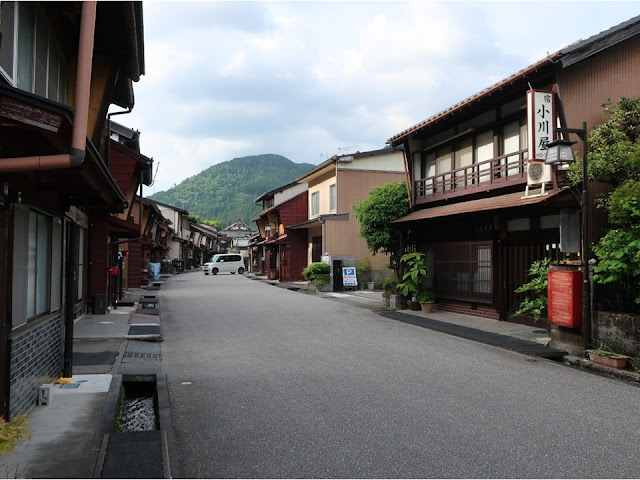URL of the part 1 of this article (Water and Life)、Part1(水と文化)のURL:
https://fun-old-japan.blogspot.com/2025/05/gujo-hachiman-hakurankan-12-part1.html
Faith in Mt. Hakusan、白山信仰
Nagataki-Hakusan Shrine in Gujo is the gateway to Mt. Hakusan (2702m), which was established as a religious mountain in 717.
郡上市には、717年に開山した白山(2702m)への三番場(登拝道の起点)のうちの一つ、長滝白山神社があります。
Mountain ascetics (priests) were engaged in missionary work; donations were gathered from central Japan (Tokai region). It is written, “Mountain ascetics not only guided worshippers to Mt. Hakusan and prayed for them, but also accommodated them at pilgrim lodge. In winter (people cannot climb because of snow), ascetics visited believers; they prayed for them, delivered talisman, medicinal herbs of mountains and map. The Buddhist image on the left was hung during missionary work at a believer’s residence, where neighbors gathered.”
白山の修験者たちは信者を増やし、東海全域から浄財が施入されるようになりました。修験者は、「夏期には先達として白山登詣の道案内、宿泊、祈祷をし、冬季にはそれぞれの霞場の信者宅を巡りお札、薬草、地図さらには祈祷をして回わり、懸仏(左)は霞場巡回に欠かせないものでした」と書かれています。各地で懸仏を披露し、白山の功徳を説き、登拝へのいざなったのですね。
Reference (the other gateway), 参考(福井県の番場)
Hakusan-Heisenji Shrine and History Hall Mahoroba、平泉寺白山神社と歴史探遊館「まほろば」
Medieval era~Early modern era、中世から近世へ
Tou clan got a territory in Gujo as a reward of the Jokyu war in 1221. They move here from eastern Japan (Chiba) in 1251.
東氏は、承久の乱で戦功をあげ、1251年、千葉から郡上に入りました。
Tou clan had produced poets. Tou Tsuneyori (1401-1494) initiated Sogi (founder of Renga poetry) into the essence of the first imperial collection of Japanese poetry (waka) “Kokin Wakashu”. The museum prioritizes on the exhibit above; it means how Gujo people are proud of the event.
東氏は代々、歌人を輩出してきました。常縁(1401-1494)は、連歌の創始者となる宗祇(1421-1502)に古今伝授(秘伝として師から弟子に伝えた『古今和歌集』の解釈の伝授)を行いました。古今伝授は郡上のキーワードになっていて、展示への力の入れようから分かるように、人々の誇りになっています。
In the Edo period (1603~1868), Gujo was developed as a castle city. The clans who ruled Gujo are shown.
近世になり、郡上は八幡城を中心とした城下町として整備されました。初代城主の娘・千代は戦乱の世を生き抜け、山内一豊(土佐24万石)の妻に。江戸末期の郡上藩は4万8千石でした。
Arts & Crafts、わざのまち八幡
Gujo is in a mountainous area; it is not easy to farm. Locals have established arts and crafts to earn a living. The major exhibit is fishing tool.
田畑が少ない山間地の郡上八幡は、特有の技を生みだしてきました。川釣りの道具が目立ちます。
Tsumugi (pongee) attracted me! A person designated as Living National Treasure also works here.
紬も美しい。人間国宝がいらっしゃいます。
Gujo is a good place for textile dyeing industry because of abundant pure water.
清流がある郡上は染め物に適しています。
Dyeing industry. I saw a craftsman was rinsing a fabric in front of his shop.
街でも晒しているのを見かけた藍染め。
Food replicas technology was pioneered by Mr. Iwasaki from Gujo. It is at a modern craft section.
現在の技で紹介されていたのが、食品サンプル。郡上出身の岩崎氏が、1932年に大阪で事業化に成功しました。
Gujo Odori dance festival、郡上踊り
The last section is about Bon dance in summer. Surprisingly enough, it is held around one and half month; they dance! The climax is the dance in mid-August. They dance overnight for three days. My acquaintance says he surely returns to Gujo during the overnight dance time. In the Edo period (1603~1868), the local government (han) prohibited samurai to join the dance. It meant the dance was so attractive.
Movie:https://www.youtube.com/watch?v=FgrUM92r-vw
(Enthusiastic dance at night)
展示の最後は郡上踊り、一月半に及ぶ踊り、そしてお盆四日間の徹夜踊りが全国的に有名です。郡上出身者は「祭りの時は必ず帰る」と言っていました。
武士に対して「盆踊り禁令」がしばしば出されたことから、こっそり加わった武士があとを絶たないほどのエキサイティングな行事だったようです。
There is a stage for visitors to dance. You can dance with locals, mainly on holiday.
郡上踊りの実演スペースがあります。土日祝を中心に開催され、一緒に踊って盛り上がれます。
The photo above shows overnight dance during the 13th to 15th of August.
8月13日から15日まで行われる徹夜踊りの熱気。
The venue in which the overnight is held is a calm street usually.
徹夜踊りが催される新町と直交する橋本町(右下)。普段は静かな通りです。
Walking around Gujo、郡上の散歩
The old street “Nakayanagi-cho” remains near the museum; it seems to be an old high way.
博覧館近くの中柳町には、旧街道のような古い町並みが残っています。
It’s also the old street “Kajiya-cho”.
江戸の雰囲気を残す鍛冶屋町。
We can see Gujo-hachiman castle from the town. It is a wooden and rebuilt castle.
町からは郡上八幡城を望めます。大垣城を参考に木造で再建された木造の城です。
The view of the town from the castle. It is said that the shape of the town looks like a fish (the fin is on the right). Do you agree?
お城からは、山間に広がる城下町が見えます。魚の形の町と呼ばれています(右が尾びれ)。
Official website: https://hakurankan.com/group_en/
https://hakurankan.com/
(in Japanese, but much info.), accessed in April, 2025
Visited in May, 2024
Previous post (first half of this article, water town): Gujo-Hachiman
Hakurankan (1/2)、郡上八幡博覧館 (part1)
Next post (museum in the same city): Hakusan cultural museum、白山文化博物館


















Comments
Post a Comment